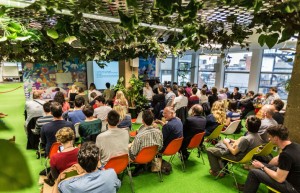At LEGup (the London Educational Games meet up) we recently hosted an event on gamification and its potential to improve educational outcomes in the classroom. Gamification is something of a hot potato at LEGup – many of our members dismiss it out of hand as nothing more than the “pointsification” of educational products in a desperate attempt to make them more engaging. Increasingly though, others are taking a more nuanced view of gamification, looking at it as a method or set of methods for employing the best entertainment game mechanics to not only increase engagement, but to improve outcomes, whether that be through better retention of information, more complete understanding of concepts or whole class involvement during activities.

Our first speaker, Dr. Wayne Holmes from Zondle (who recently completed his Ph.D. in education from Oxford University) has a much more rigorous approach to creating good games-based learning (GBL) products than many other GBL startups can claim. Zondle uses a suite of different games as shells into which teachers can add their own questions. So far, over 100 million questions have been created in the system. Dr. Holmes uses his own research and the research of other academics such as Learning Scientist Sasha Barab and neuroscientist Dr. Paul Howard Jones to test and refine the game mechanics which make Zondle such a successful exam-revision tool for teachers and students around the world. Despite this rigorous underpinning though, Zondle has suffered from its association with gamification. According to Dr. Holmes, some critics dismiss it as a gimmick without having fully realized the research that has gone into it. Some audience members questioned the research and Dr. Holmes was at pains to point out that ‘not all research is good research’. He also highlighted that academics too often exist in silos, and that for educational research to take giant strides forward we need neuroscientists, teachers and psychologists in the same room. You can find out more about the research underpinning Zondle by watching Dr. Holmes’ talk here.
Jamie Brooker, from Kahoot! (a platform for sharing student and teacher-generated questions in the classroom and across devices) is another proponent of gamification in education. Kahoot! was borne out of research conducted at the Norwegian University of Technology and Science by Professor Alf Inge Wang. Jamie was keen to underline Wayne’s point that good research should underpin games-based learning products. Kahoot! is used in different ways in the classroom, for example to help with formative assessment and to reinforce understanding of concepts by repeating the same questions at intervals to check retention. Jamie showed us a video of a class using Kahoot! and the engagement level was high as students raced to answer a question and then see the class results appear on the IWB in real time. Teachers have also reported that using Kahoot! as a vehicle for testing removes a lot of the pressure students feel when they know they are being tested. The makers of Kahoot! have a very close releationship with the teachers who use their product, and Jamie stressed that a lot of the teachers they talk to are highly enthusiastic about gamifying their classroom, and use Kahoot! as a means to doing this. He feels that gamification in schools is not just about the students, but also the teachers, who actively enjoy creating and personalising their own content within the system. You can watch his talk here.
Our final speaker, Eiman Munro of Elementals, took us in a new direction. Her products are traditional card games which attempt to teach different aspects of the science curriculum (for example the elements of the periodic table). Her products take inspiration from well-known game mechanics, such as the concept of Top Trumps or the collectability of Pokemon cards, to increase student engagement. One mechanic she talked us through was “loop games”, commonly used during the plenary section of a class to summarize topics. Card sets contain pairs of questions and answers, randomly distributed around the class. Each student takes a turn to read out a question, and the rest of the class must pay close attention to see if their answer is the correct one. Other successful mechanics include using the rock/paper/scissors concept to teach the relationship between solids, liquids and gases. She has used her experiences testing her card games with children to revise and improve the mechanics of each game. For example, a particular game will focus on one aspect of the periodic table, rather than attempting to cover all of it, in recognition of the fact that it is much harder for students to memorize large data sets in one attempt. She introduced us to her product Elemons, a “living card game” as opposed to a “collectible card game”, which equates different elements from the periodic table with characters who display special powers. Eiman markets her games through toy and game fairs, rather than direct to schools, and doesn’t explicitly label them as “educational games” because she prefers a child-led approach where the child decides to learn, rather than having the game imposed on them. You can watch her talk here.
 Kirsten Campbell-Howes is an edtech veteran who works as a consultant in the European startup space. She is currently working with a global telecoms company on a mobile-learning product in Africa and Latin America. She also co-runs the website edugameshub.com and the hugely popular London Educational Games Meetup Group, AKA #LEGup.
Kirsten Campbell-Howes is an edtech veteran who works as a consultant in the European startup space. She is currently working with a global telecoms company on a mobile-learning product in Africa and Latin America. She also co-runs the website edugameshub.com and the hugely popular London Educational Games Meetup Group, AKA #LEGup.
Twitter: @campbellhowes @edugameshub


